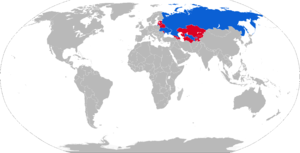BMD-2
The BMD-2 is a Soviet airborne infantry fighting vehicle, introduced in 1985. It is a variant of BMD-1 with a new turret and some changes done to the hull. BMD stands for Boyevaya Mashina Desanta (Боевая Машина Десанта, which literally translates to "Airborne Combat Vehicle").[1] It was developed as a replacement of BMD-1 but it failed to replace it completely because of the downfall of Soviet economy in 1980s. NATO gave it the designation BMD M1981/1.[2]
| BMD-2 | |
|---|---|
A Ukrainian BMD-2 on parade at Kiev in August 2008 | |
| Type | Airborne infantry fighting vehicle |
| Place of origin | Soviet Union |
| Service history | |
| In service | 1985–present |
| Used by | See Operators |
| Wars | See Service history |
| Production history | |
| Designed | 1981–1985 |
| Manufacturer | Volgograd Tractor Plant |
| Produced | 1985–1991? (out of production) |
| Variants | See Variants |
| Specifications (BMD-2) | |
| Mass | 11.5 tonnes |
| Length | 7.85 m |
| Width | 2.94 m |
| Height | 2.45 m |
| Crew | 4 (commander, driver, gunner and bow machine gunner) (+ 4 troopers) |
| Armor | Welded aluminium alloy 7 mm turret 15 mm at 78° upper hull front 15 mm at 50° lower hull front 10 mm rest of the hull |
Main armament | 30 mm 2A42 multi-purpose autocannon (300 rounds (180 AP and 120 HE)) 9P135M-1 ATGM launcher |
Secondary armament | 7.62 mm PKT coaxial tank machine gun 7.62 mm PKT bow tank machine gun 2,940 7.62 mm machine gun rounds |
| Engine | 5D-20 6-cylinder 4-stroke V-shaped liquid cooled 15.9 liter diesel 241 hp (180 kW) at 2,600 rpm |
| Power/weight | 21 hp/tonne (15.7 kW/tonne) |
| Suspension | torsion-bar |
| Ground clearance | Adjustable 100 mm to 450 mm |
| Fuel capacity | 300 l |
Operational range | 450 km (road) |
| Maximum speed | 80 km/h (road) 40 km/h (cross country) 10 km/h (swimming) |
Development
When the Soviet–Afghan War broke out, the Soviet forces operated BMP-1 IFVs and BMD-1 airborne IFVs. They were both armed with 73 mm 2A28 "Grom" low pressure smoothbore short-recoil semi-automatic gun, 9S428 ATGM launcher capable of firing 9M14 "Malyutka" (NATO: AT-3A Sagger A), 9M14M "Malyutka-M" (NATO: AT-3B Sagger B) and 9M14P "Malyutka-P" (NATO: AT-3C Sagger C) ATGMs and 7.62 mm PKT coaxial tank machine gun. Although their armament made for strong anti-tank firepower, it didn't provide sufficient firepower against enemy unarmored vehicles, infantry, firing points and light fortified positions, especially during mountain battles because of low elevation angle of the main gun.
In 1981 the units fighting in Afghanistan started receiving new BMP-2 IFVs. Its 30 mm 2A42 multi-purpose autocannon with two-belt loading system and very high elevation angle solved some of the serious drawbacks of the 73 mm 2A28 "Grom" gun. Also the 9S428 ATGM launcher was replaced by pintle-mounted 9P135M-1 ATGM launcher with semi-automatic control capable of firing SACLOS guided 9M113 "Konkurs" (AT-5 Spandrel), 9M113M "Konkurs-M" (AT-5B Spandrel B), 9M111 "Fagot" (AT-4 Spigot) and 9M111-2 "Fagot" (AT-4B Spigot B) ATGMs which proved to be much more effective and reliable than the MCLOS guided 9M14 "Malyutka" (AT-3 Sagger), 9M14M "Malyutka-M" (AT-3B Sagger B) and 9M14P "Malyutka-P" (AT-3C Sagger C) ATGMs. Because of that the high command of Soviet airborne forces decided to arm their units with similar vehicles.
In the beginning it became obvious that the hull of BMD-1 was too small for the BMP-2 turret. Therefore, it was decided to design two vehicles. The first one was supposed to satisfy the immediate need of a new airborne IFV by modifying the BMD-1/BMP-1 turret, arming it with the same armament as the one on the BMP-2 and then fitting it onto the BMD-1 hull. The second vehicle was supposed to be much bigger to allow fitting of the BMP-2 turret and later became the BMD-3.
The modernized variant of BMD-1 was developed in 1983 and incorporated the new B-30 turret armed with 30 mm 2A42 multi-purpose autocannon, 7.62 mm PKT coaxial tank machine gun and pintle-mounted 9P135M-1 ATGM launcher. After it passed the trials it entered production in 1985.
Description
Overview
BMD-2 has a slightly modernized BMD-1 hull and a new turret.
Crew
The BMD-2's crew is the same as the one in BMD-1 with slight changes like the fact that the commander no longer operates the left bow-mounted 7.62 mm PKT tank machine gun which was removed because the trials proved that he is too consumed by his primary duties to accurately fire it. He also received the R-123M radio set for communication.
The new turret seats the gunner on the left hand side of the main gun. On top of the turret there's one single piece circular hatch opening to the front. Located in front of the said hatch is the gunner's sight which is the same one as the one used in BMP-2. Another gunner's sight is located on the left hand side of the main gun and moves in vertical planes along with it. It is a high angle of fire sight used when the gunner is aiming at air targets. The vehicle also has additional periscopes that provide it with vision on the sides. A white searchlight is mounted in front of the turret.
Turret
The B-30 turret is a modified version of the BMP-1/BMD-1 turret.
Armament
.jpg)
The vehicle is armed with stabilized 30 mm 2A42 multi-purpose autocannon and 7.62 mm PKT coaxial tank machine gun (mounted on the right hand side of the main gun). The vehicle carries 300 rounds for the main gun (180 AP and 120 HE) and 2,940 rounds for the machine gun. The main gun can be elevated or depressed between 75° and -5° and can be used to fire at air targets. The turret is also armed with pintle-mounted 9P135M-1 ATGM launcher, on the right hand side of the roof of the turret, with semi-automatic control capable of firing SACLOS guided 9M113 "Konkurs" (AT-5 Spandrel), 9M113M "Konkurs-M" (AT-5B Spandrel B), 9M111 "Fagot" (AT-4 Spigot) and 9M111-2 "Fagot" (AT-4B Spigot B) ATGMs.
Maneuverability
The BMD-2 has the same engine and same suspension as the BMD-1 but it has a maximum road operational range of 450 km.
Air-drop techniques
.jpg)
The vehicle can be transported by An-12, An-22, Il-76, An-124 airplanes and Mi-6 and Mi-26 helicopters.
A rocket parachute, the PRSM-915, was developed to ensure the vehicle's safe landing.[3] To use the parachute, the BMD is first packed onto a special pallet before takeoff. To drop the BMD, a drogue chute is released that initially drags the BMD out of the Il-76 transport plane. Once clear of the plane a single large main chute opens. The deployment of the main chute triggers the deployment of four long rods which hang beneath the pallet. As soon as the rods touch the ground a retrorocket fires, slowing the BMD to a descending speed between 6 m/s and 7 m/s and giving it a relatively soft landing.[4] It allowed a BMD to be relatively safely parachuted with both the driver and the gunner. This system entered service in 1975 for the BMD-1, and was always used for the BMD-2 afterwards.
Amphibious ability
The BMD-2 is fully amphibious, it can swim after switching on the two electric bilge pumps, erecting the two piece trim vane which improves vehicle's stability and displacement in water and prevents the water from flooding the bow of the tank and switching the driver's periscope for a swimming periscope that enables the driver to see over the trim vane.
Armour protection
The aluminium armour thickness is 7 mm on the turret, 15 mm on the front of the hull and 10 mm on the rest of the hull. Hull's front armour has two sections: upper and lower. The upper section is angled at 78° while the lower one is angled at 50°. It's resistant to small arms fire and shrapnel.
Troop compartment
.jpg)
The design was made in order to save necessary weight, and sacrifices crew comfort.[5] Like the BMD-1, the BMD-2 has an extremely cramped interior space. It is much smaller than the ones inside the BMP-1 and BMP-2 IFVs. It can carry five infantrymen, including vehicle's commander, bow machine gunner and three soldiers seated behind the turret.
It is equipped with periscope vision blocks on the sides and rear of the vehicle. Also there are only three firing ports, two on each side of the hull and one in the rear.[5]
Equipment
The BMD-2 has the same equipment except for the R-123 radio set which was replaced by the R-123M radio set.
Service history

BMD-2 entered service with Soviet airborne forces in 1985. They took part in Soviet–Afghan War. Later they were used by Russian airborne units of SFOR including the Russian airborne brigade stationed in Tojsici which supported the Operation Joint Guard. It is also used by Russian airborne units stationed in Abkhazia. BMD-2s were also employed by Russian 234th Airborne Assault Regiment in the Russo-Georgian War in 2008, one of their number being lost in action.
War in Donbass
BMD-2s were used by units of the Ukrainian Airmobile Forces, and by separatists of Novorossiya. Ukrainian Airborne BMD-2s were some of the first armored vehicles destroyed in the conflict. At least one BMD-2 was reported to have been used by separatists while they were besieged in the city of Sloviansk,[6] and others separatists BMD-2s were recorded in action.
Variants
- BMD-2 (Ob'yekt 916) – The basic model
- BMD-2K (K stands for komandirskaya – command) – Command variant fitted with an additional antennae.
- BMD-2M – BMD-2 modernization. It features a number of improvements including fitting of smoke grenade launchers to the side of the turret, 2 launchers for ATGM 9M133 "Kornet" and new day/night sights.[7]
Operators

Current operators
Former operators

References
| Wikimedia Commons has media related to BMD-2. |
- "†" (PDF). Archived from the original (PDF) on 27 February 2008.
- John Pike. "BMD-1 Airborne Infantry Fighting Vehicle". Retrieved 15 December 2014.
- "Test of PRSM-925 parachute with retrorocket". Retrieved 4 March 2014.
- "Parachutes with retro rockets". Retrieved 4 March 2014.
- Maksim Sayenko. "Bronya »krylyatoy pyekhoty«" (Armour of "Winged infantry"). Tekhnika i Vooruzhenie no.08/2006, p. 28-32 (in Russian). Retrieved 4 March 2014.
- Стрєлков: "Ополченці" вбиватимуть українських військових, якщо ті надалі виконуватимуть свої обов'язки. Ukrinform, 26 April 2014
- http://www.military-today.com/apc/bmd2.htm
- "BMD-2". Archived from the original on 19 February 2013. Retrieved 15 December 2014.